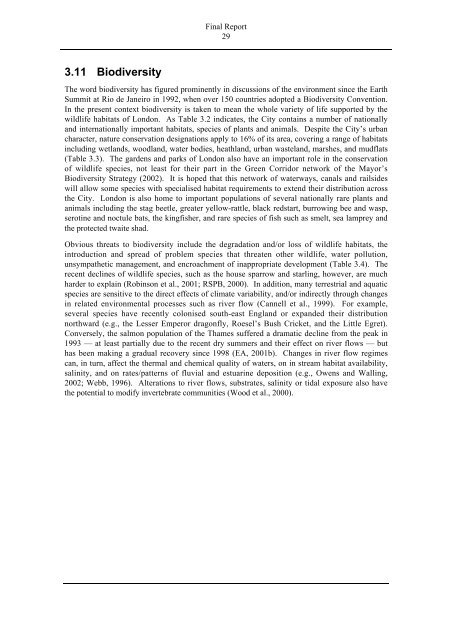London scoping - ukcip
London scoping - ukcip
London scoping - ukcip
You also want an ePaper? Increase the reach of your titles
YUMPU automatically turns print PDFs into web optimized ePapers that Google loves.
3.11 Biodiversity<br />
Final Report<br />
29<br />
The word biodiversity has figured prominently in discussions of the environment since the Earth<br />
Summit at Rio de Janeiro in 1992, when over 150 countries adopted a Biodiversity Convention.<br />
In the present context biodiversity is taken to mean the whole variety of life supported by the<br />
wildlife habitats of <strong>London</strong>. As Table 3.2 indicates, the City contains a number of nationally<br />
and internationally important habitats, species of plants and animals. Despite the City’s urban<br />
character, nature conservation designations apply to 16% of its area, covering a range of habitats<br />
including wetlands, woodland, water bodies, heathland, urban wasteland, marshes, and mudflats<br />
(Table 3.3). The gardens and parks of <strong>London</strong> also have an important role in the conservation<br />
of wildlife species, not least for their part in the Green Corridor network of the Mayor’s<br />
Biodiversity Strategy (2002). It is hoped that this network of waterways, canals and railsides<br />
will allow some species with specialised habitat requirements to extend their distribution across<br />
the City. <strong>London</strong> is also home to important populations of several nationally rare plants and<br />
animals including the stag beetle, greater yellow-rattle, black redstart, burrowing bee and wasp,<br />
serotine and noctule bats, the kingfisher, and rare species of fish such as smelt, sea lamprey and<br />
the protected twaite shad.<br />
Obvious threats to biodiversity include the degradation and/or loss of wildlife habitats, the<br />
introduction and spread of problem species that threaten other wildlife, water pollution,<br />
unsympathetic management, and encroachment of inappropriate development (Table 3.4). The<br />
recent declines of wildlife species, such as the house sparrow and starling, however, are much<br />
harder to explain (Robinson et al., 2001; RSPB, 2000). In addition, many terrestrial and aquatic<br />
species are sensitive to the direct effects of climate variability, and/or indirectly through changes<br />
in related environmental processes such as river flow (Cannell et al., 1999). For example,<br />
several species have recently colonised south-east England or expanded their distribution<br />
northward (e.g., the Lesser Emperor dragonfly, Roesel’s Bush Cricket, and the Little Egret).<br />
Conversely, the salmon population of the Thames suffered a dramatic decline from the peak in<br />
1993 — at least partially due to the recent dry summers and their effect on river flows — but<br />
has been making a gradual recovery since 1998 (EA, 2001b). Changes in river flow regimes<br />
can, in turn, affect the thermal and chemical quality of waters, on in stream habitat availability,<br />
salinity, and on rates/patterns of fluvial and estuarine deposition (e.g., Owens and Walling,<br />
2002; Webb, 1996). Alterations to river flows, substrates, salinity or tidal exposure also have<br />
the potential to modify invertebrate communities (Wood et al., 2000).

















